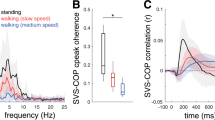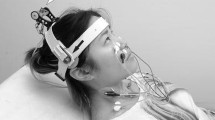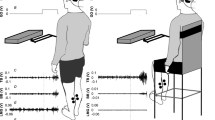Summary
The aim of this study was to determine whether vestibular information related to head acceleration is available for triggering postural responses to perturbations of stance in the freely-standing cat. Linear accelerations of the head were recorded during postural responses evoked by linear translations of the support surface. A consistent initial peak of acceleration was observed at an average latency of 22 ms and magnitude of 0.03 g (g is acceleration due to gravity, 9.8 m/s/s). The acceleration peak preceded the first evoked EMG activity by an average of 24 ms. It was concluded that stimulation of the vestibular apparatus was both adequate and early enough for the vestibular system to have triggered the automatic postural response.
Similar content being viewed by others
References
Carpenter MB, Fabrega H, Glinsmann W (1959) Physiological deficits occurring with lesions of labyrinth and fastigial nuclei. J Neurophysiol 22: 222–234
Dickman JD, Correia MJ (1989) Responses of pigeon horizontal semicircular canal afferent fibres. II. High-frequency mechanical stimulation. J Neurophysiol 62: 1102–1112
Dow RS (1938) The effects of unilateral and bilateral labyrinthectomy in monkey, baboon and chimpanzee. Am J Physiol 121: 392–399
Fernandez C, Goldberg JM (1976) Physiology of peripheral neurons innervating otolith organs of the squirrel monkey. III. Response dynamics. J Neurophysiol 39: 996–1008
Gernandt BE, Katsuki Y, Livingston RB (1957) Functional organization of descending vestibular influences. J Neurophysiol 20: 453–469
Gruner JA (1989) Comparison of vestibular and auditory startle responses in the rat and cat. J Neurosci Meth 27: 13–24
Horak FB, Nashner LM, Diener HC (1990) Postural strategies associated with somatosensory and vestibular loss. Exp Brain Res 82: 167–177
Lacour M, Borel L, Barthelemy J, Harlay F, Xerri C (1987) Dynamic properties of the vertical otolith neck reflexes in the alert cat. Exp Brain Res 65: 559–568
Lacour M, Xerri C, Hugon M (1978) Muscle responses and monosynaptic reflexes in falling monkey. Role of the vestibular system. J Physiol (Paris) 74: 427–438
Macpherson JM (1988) Strategies that simplify the control of quadrupedal stance. 2. Electromyographic activity. J Neurophysiol 60: 218–231
Macpherson JM, Lywood DW, Van Eyken A (1987) A system for the analysis of posture and stance in quadrupeds. J Neurosci Meth 20: 73–82
Macpherson J, Rushmer DS, Dunbar DC (1986) Postural responses in the cat to unexpected rotations of the supporting surface: evidence for a centrally generated synergic organization. Exp Brain Res. 62: 152–160
Magnus R (1926) On the co-operation and interference of reflexes from other sense organs with those of the labyrinths. The Laryngoscope 36: 701–712
Marlinski VV, Tsintsabadze FI (1989) Effects of adequate vestibular stimulation on locomotor activity in fore- and hindlimb musclesin the guinea pig. Movement along a vertical axis. Neurophysiology 21: 144–148
Money KE, Scott JW (1962) Functions of separate sensory receptors of nonauditory labyrinth of the cat. Am J Physiol 202: 1211–1220
Mori S, Brookhart JM (1968) Characteristics of the postural reactions of the dog to a controlled disturbance. Am J Physiol 215: 339–348
Northington P, Barrera SE (1934) Effects of unilateral and bilateral labyrinthectomy and intracranial section of eighth nerve. Arch Neurol Psychiatr 32: 51–71
Precht W, Shimazu H (1965) Functional connections of tonic and kinetic vestibular neurons with primary vestibular afferents. J Neurophysiol 28: 1014–1028
Rushmer DS, Russel CJ, Macpherson JM, Phillips JO, Dunbar DC (1983) Automatic postural responses in the cat: responses to headward and tailward translation. Exp Brain Res 50: 45–61
Watt DGD (1976) Responses of cats to sudden falls: an otolithoriginating reflex assisting landing. J Neurophysiol 39: 257–265
Wilson VJ, Kato M, Peterson BW, Wylie RM (1967) A single-unit analysis of the organization of Deiter's nucleus. J Neurophysiol 30: 603–619
Xerri C, Barthelemy J, Harlay F, Borel L, Lacour M (1987) Neuronal coding of linear motion in the vestibular nuclei of the alert cat. 1. Response characteristics to vertical otolith stimulation. Exp Brain Res 65: 569–581
Author information
Authors and Affiliations
Rights and permissions
About this article
Cite this article
Inglis, J.T., Macpherson, J.M. Head acceleration following linear translations in the freely-standing cat. Exp Brain Res 87, 108–112 (1991). https://doi.org/10.1007/BF00228511
Received:
Accepted:
Issue Date:
DOI: https://doi.org/10.1007/BF00228511




